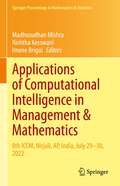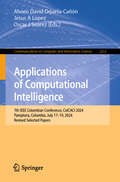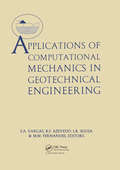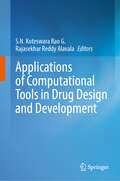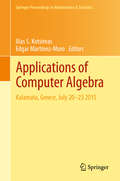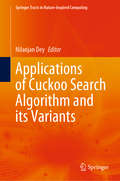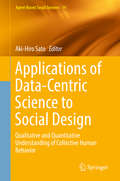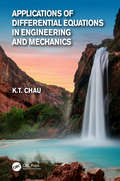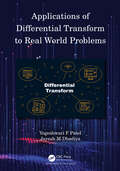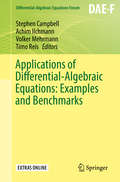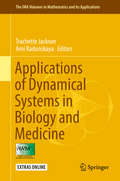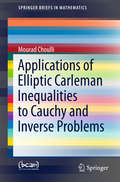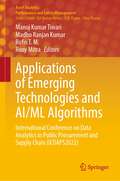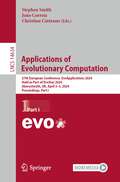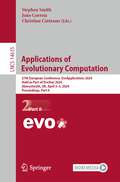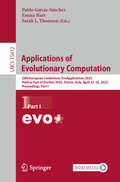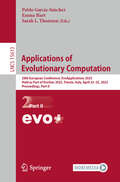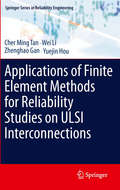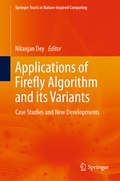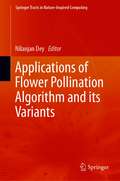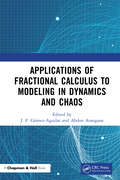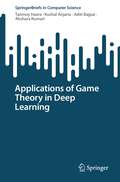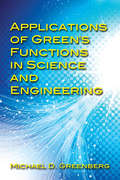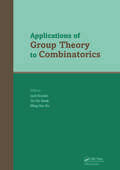- Table View
- List View
Applications of Computational Intelligence in Management & Mathematics: 8th ICCM, Nirjuli, AP, India, July 29–30, 2022 (Springer Proceedings in Mathematics & Statistics #417)
by Nishtha Kesswani Imene Brigui Madhusudhan MishraComputational intelligence consists of those techniques that imitate the human brain and nature to adopt the decision-making approach. This book contains selected papers from the 8th International Conference on Computers, Management and Mathematical Sciences (ICCM) 2022 about fuzzy systems, neural networks and evolutionary computation that can address stochastic environments where reasoning is a significant attribute to derive potential solutions and focus on the business domain's computational aspects.This is a conference proceedings for scholars/students who are using the powerful algorithms, concepts and principles of computational intelligence in a wide spectrum of research cases.
Applications of Computational Intelligence: 7th IEEE Colombian Conference, ColCACI 2024, Pamplona, Colombia, July 17–19, 2024, Revised Selected Papers (Communications in Computer and Information Science #2212)
by Alvaro David Orjuela-Cañón Oscar J. Suarez Jesus A. LopezThis book CCIS 2212 constitutes the referred proceedings of the 7th IEEE Colombian Conference on Applications of Computational Intelligence, ColCACI 2024, held in Pamplona, Colombia, during July 17–19, 2024. The 11 full papers were carefully reviewed and selected from 35 submissions. They explore various topics in the area of computational intelligence (CI), such as solar and photovoltaic forecasting, microseismical signal analysis, LLM performance analysis, evolution in translate systems, recognition of actors and peacebuilding, control in autonomous vehicles, and electroencephalography signals analysis.
Applications of Computational Mechanics in Geotechnical Engineering
by E.A.VARGAS; R.F.AZEVEDO; L.M.RIBEIRO E SOUSA; M.MATOS FERNANDESThe development of constitutive relations for geotechnical materials, with the help of numerical models, have increased notably the ability to predict and to interpret the mechanical behaviour of geotechnical works. This work covers rock excavations, soil excavations, earth fills and dams.
Applications of Computational Tools in Drug Design and Development
by S. N. Koteswara Rao G. Rajasekhar Reddy AlavalaThis book provides a comprehensive overview of the role of computers and computational tools at different stages of drug discovery and development. Designed to meet the needs of a beginner to advanced learner, the book provides the information on the tools, how they work, with the latest reports on applications in drug design, drug delivery and building network pharmacology models. Part I explores the pharmacological aspects, covering computational simulation of drug delivery at the molecular level, modeling for formulation design, and the revolutionary use of computational fluid dynamics in pharmaceutical processes. Specific applications such as pharmaceutical die filling processes, inhalation aerosol-based targeted drug delivery, and the development of inhalation compounds using in silico modeling tools are discussed. The use of computational tools in cheminformatics and their application in preformulation perspectives for drug delivery are also included. Part II expands the scope to include solubility prediction, absorption prediction, protein binding prediction, bio-permeability prediction, toxicity prediction, and metabolism prediction. It covers the identification of potential sites of metabolism in lead molecules and computer-assisted simulation studies to understand drug-polymer interactions. Recent advances in drug likeness screening using software and online tools are also reviewed. Part III focuses on specific therapeutic areas. <span class=
Applications of Computer Algebra: Kalamata, Greece, July 20–23 2015 (Springer Proceedings in Mathematics & Statistics #198)
by Ilias S. Kotsireas Edgar Martínez-MoroThe Applications of Computer Algebra (ACA) conference covers a wide range of topics from Coding Theory to Differential Algebra to Quantam Computing, focusing on the interactions of these and other areas with the discipline of Computer Algebra. This volume provides the latest developments in the field as well as its applications in various domains, including communications, modelling, and theoretical physics. The book will appeal to researchers and professors of computer algebra, applied mathematics, and computer science, as well as to engineers and computer scientists engaged in research and development.
Applications of Cuckoo Search Algorithm and its Variants (Springer Tracts in Nature-Inspired Computing)
by Nilanjan DeyThis book highlights the basic concepts of the CS algorithm and its variants, and their use in solving diverse optimization problems in medical and engineering applications. Evolutionary-based meta-heuristic approaches are increasingly being applied to solve complicated optimization problems in several real-world applications. One of the most successful optimization algorithms is the Cuckoo search (CS), which has become an active research area to solve N-dimensional and linear/nonlinear optimization problems using simple mathematical processes. CS has attracted the attention of various researchers, resulting in the emergence of numerous variants of the basic CS with enhanced performance since 2019.
Applications of Data-Centric Science to Social Design: Qualitative and Quantitative Understanding of Collective Human Behavior (Agent-Based Social Systems #14)
by Aki-Hiro SatoThe intention behind this book is to illustrate the deep relation among human behavior, data-centric science, and social design. In fact, these three issues have been independently developing in different fields, although they are, of course, deeply interrelated to one another. Specifically, fundamental understanding of human behavior should be employed for investigating our human society and designing social systems. Insights and both quantitative and qualitative understandings of collective human behavior are quite useful when social systems are designed. Fundamental principles of human behavior, theoretical models of human behavior, and information cascades are addressed as aspects of human behavior. Data-driven investigation of human nature, social behavior, and societal systems are developed as aspects of data-centric science. As design aspects, how to design social systems from heterogeneous memberships is explained. There is also discussion of these three aspects—human behavior, data-centric science, and social design—independently and with regard to the relationships among them.
Applications of Differential Equations in Engineering and Mechanics
by Kam Tim ChauThis second of two comprehensive reference texts on differential equations continues coverage of the essential material students they are likely to encounter in solving engineering and mechanics problems across the field - alongside a preliminary volume on theory. This book covers a very broad range of problems, including beams and columns, plates, shells, structural dynamics, catenary and cable suspension bridge, nonlinear buckling, transports and waves in fluids, geophysical fluid flows, nonlinear waves and solitons, Maxwell equations, Schrodinger equations, celestial mechanics and fracture mechanics and dynamics. The focus is on the mathematical technique for solving the differential equations involved. All readers who are concerned with and interested in engineering mechanics problems, climate change, and nanotechnology will find topics covered in this book providing valuable information and mathematics background for their multi-disciplinary research and education.
Applications of Differential Transform to Real World Problems
by Yogeshwari F Patel Jayesh M DhodiyaThis book is an invaluable resource for applied researchers to find the analytical solution of differential equations describing the dynamical system with less computational effort and time. It describes the basic concepts of the differential transform method and solution of various real-world problems described by simple to complicated differential equations. It provides a computational technique that is not only conceptually simple and easy to use but also readily adaptable for computer coding. Different chapters of the book deal with the basic differential equations involved in the physical phenomena as well as a complicated system of differential equations described by the mathematical model.The book offers comprehensive coverage of the most essential topics, including Basic concepts and fundamental properties of the proposed technique with proof The solution of linear, nonlinear, homogeneous, and nonhomogeneous ordinary differential equations (ODEs) and partial differential equations (PDEs) The initial and boundary value problems Real-world ODE and PDE problems are also discussed Applications of Differential Transform to Real World Problems is primarily aimed at undergraduates, graduates, and researchers studying differential equations. Scientists dealing with complicated differential equations or systems of differential equations will also find this book useful.
Applications of Differential-Algebraic Equations: Examples and Benchmarks (Differential-Algebraic Equations Forum)
by Achim Ilchmann Timo Reis Volker Mehrmann Stephen CampbellThis volume encompasses prototypical, innovative and emerging examples and benchmarks of Differential-Algebraic Equations (DAEs) and their applications, such as electrical networks, chemical reactors, multibody systems, and multiphysics models, to name but a few. Each article begins with an exposition of modelling, explaining whether the model is prototypical and for which applications it is used. This is followed by a mathematical analysis, and if appropriate, a discussion of the numerical aspects including simulation. Additionally, benchmark examples are included throughout the text.Mathematicians, engineers, and other scientists, working in both academia and industry either on differential-algebraic equations and systems or on problems where the tools and insight provided by differential-algebraic equations could be useful, would find this book resourceful.
Applications of Dynamical Systems in Biology and Medicine (The IMA Volumes in Mathematics and its Applications #158)
by Trachette Jackson Ami RadunskayaThis volume highlights problems from a range of biological and medical applications that can be interpreted as questions about system behavior or control. Topics include drug resistance in cancer and malaria, biological fluid dynamics, auto-regulation in the kidney, anti-coagulation therapy, evolutionary diversification and photo-transduction. Mathematical techniques used to describe and investigate these biological and medical problems include ordinary, partial and stochastic differentiation equations, hybrid discrete-continuous approaches, as well as 2 and 3D numerical simulation.
Applications of Elliptic Carleman Inequalities to Cauchy and Inverse Problems (SpringerBriefs in Mathematics)
by Mourad ChoulliThis book presents a unifiedapproach to studying the stability of both elliptic Cauchy problems and selectedinverse problems. Based on elementary Carleman inequalities, it establishesthree-ball inequalities, which are the key to deriving logarithmic stabilityestimates for elliptic Cauchy problems and are also useful in proving stabilityestimates for certain elliptic inverse problems. The book presents three inverseproblems, the first of which consists in determining the surface impedance ofan obstacle from the far field pattern. The second problem investigates the detectionof corrosion by electric measurement, while the third concerns thedetermination of an attenuation coefficient from internal data, which ismotivated by a problem encountered in biomedical imaging.
Applications of Emerging Technologies and AI/ML Algorithms: International Conference on Data Analytics in Public Procurement and Supply Chain (ICDAPS2022) (Asset Analytics)
by Manoj Kumar Tiwari Madhu Ranjan Kumar Rofin T. M. Rony MitraThis book provides practical insights into applications of the state-of-the-art of Machine Learning and Artificial Intelligence (AI) for solving intriguing and complex problems in procurement and supply chain management. The application domain includes perishable food supply chain, steel price prediction, electric vehicle charging infrastructure design, contract price negotiation, reverse logistics network design, and demand forecasting. Further, the book highlights the advanced topics in the procurement field, like AI in green procurement and e-procurement in the pharma sector. Furthermore, the book covers applications of well-established methodologies such as heuristics, optimization, game theory, and MCDM based on the nature of the problem. The inclusion of the vaccine supply chain digital twin and blockchain-based procurement signals the significance of the book. This book is a comprehensive guide for industry professionals to understand the power of data analytics, enabling them to improve efficiency and effectiveness in the procurement and supply chain sectors.
Applications of Evolutionary Computation: 27th European Conference, EvoApplications 2024, Held as Part of EvoStar 2024, Aberystwyth, UK, April 3–5, 2024, Proceedings, Part I (Lecture Notes in Computer Science #14634)
by Stephen Smith João Correia Christian CintranoThe two-volume set LNCS 14634 and 14635 constitutes the refereed proceedings of the 27th European Conference on Applications of Evolutionary Computation, EvoApplications 2024, held as part of EvoStar 2024, in Aberystwyth, UK, April 3–5, 2024, and co-located with the EvoStar events, EvoCOP, EvoMUSART, and EuroGP.The 51 full papers presented in these proceedings were carefully reviewed and selected from 77 submissions. The papers have been organized in the following topical sections: applications of evolutionary computation; analysis of evolutionary computation methods: theory, empirics, and real-world applications; computational intelligence for sustainability; evolutionary computation in edge, fog, and cloud computing; evolutionary computation in image analysis, signal processing and pattern recognition; evolutionary machine learning; machine learning and AI in digital healthcare and personalized medicine; problem landscape analysis for efficient optimization; softcomputing applied to games; and surrogate-assisted evolutionary optimisation.
Applications of Evolutionary Computation: 27th European Conference, EvoApplications 2024, Held as Part of EvoStar 2024, Aberystwyth, UK, April 3–5, 2024, Proceedings, Part II (Lecture Notes in Computer Science #14635)
by Stephen Smith João Correia Christian CintranoThe two-volume set LNCS 14634 and 14635 constitutes the refereed proceedings of the 27th European Conference on Applications of Evolutionary Computation, EvoApplications 2024, held as part of EvoStar 2024, in Aberystwyth, UK, April 3–5, 2024, and co-located with the EvoStar events, EvoCOP, EvoMUSART, and EuroGP.The 51 full papers presented in these proceedings were carefully reviewed and selected from 77 submissions. The papers have been organized in the following topical sections: applications of evolutionary computation; analysis of evolutionary computation methods: theory, empirics, and real-world applications; computational intelligence for sustainability; evolutionary computation in edge, fog, and cloud computing; evolutionary computation in image analysis, signal processing and pattern recognition; evolutionary machine learning; machine learning and AI in digital healthcare and personalized medicine; problem landscape analysis for efficient optimization; softcomputing applied to games; and surrogate-assisted evolutionary optimisation.
Applications of Evolutionary Computation: 28th European Conference, EvoApplications 2025, Held as Part of EvoStar 2025, Trieste, Italy, April 23–25, 2025, Proceedings, Part I (Lecture Notes in Computer Science #15612)
by Sarah L. Thomson Emma Hart Pablo García-SánchezThis two-volume set, LNCS 15612 and 15613 constitutes the refereed proceedings of the 28th European Conference on Applications of Evolutionary Computation, EvoApplications 2025, held as part of EvoStar 2025, in Trieste, Italy, during April 23–25, 2025, and co-located with the EvoStar events, EvoCOP, EvoMUSART, and EuroGP. The 50 full papers and 18 short papers presented in this book were carefully reviewed and selected from 104 submissions. These papers have been organized in the following topical sections: Part I: EvoApplications.Part II: Evolutionary machine learning; 30 years of particle swarm optimisation; Analysis of Evolutionary Computation Methods: Theory, Empirics, and Real-World Applications; Bio-inspired Algorithms for Green Computing and Sustainable Complex Systems; Computational Intelligence for Sustainability; EvoLLMs (Integrating Evolutionary Computing with Large Language Models (LLMs); Evolutionary Computation in Edge, Fog, and Cloud Computing; Evolutionary Computation in Image Analysis, Signal Processing, and Pattern Recognition; Machine Learning and AI in Digital Healthcare and Personalized Medicine; Soft Computing Applied to Games.
Applications of Evolutionary Computation: 28th European Conference, EvoApplications 2025, Held as Part of EvoStar 2025, Trieste, Italy, April 23–25, 2025, Proceedings, Part II (Lecture Notes in Computer Science #15613)
by Sarah L. Thomson Emma Hart Pablo García-SánchezThis two-volume set, LNCS 15612 and 15613 constitutes the refereed proceedings of the 28th European Conference on Applications of Evolutionary Computation, EvoApplications 2025, held as part of EvoStar 2025, in Trieste, Italy, during April 23–25, 2025, and co-located with the EvoStar events, EvoCOP, EvoMUSART, and EuroGP. The 50 full papers and 18 short papers presented in this book were carefully reviewed and selected from 104 submissions. These papers have been organized in the following topical sections: Part I: EvoApplications.Part II: Evolutionary machine learning; 30 years of particle swarm optimisation; Analysis of Evolutionary Computation Methods: Theory, Empirics, and Real-World Applications; Bio-inspired Algorithms for Green Computing and Sustainable Complex Systems; Computational Intelligence for Sustainability; EvoLLMs (Integrating Evolutionary Computing with Large Language Models (LLMs); Evolutionary Computation in Edge, Fog, and Cloud Computing; Evolutionary Computation in Image Analysis, Signal Processing, and Pattern Recognition; Machine Learning and AI in Digital Healthcare and Personalized Medicine; Soft Computing Applied to Games.
Applications of Finite Element Methods for Reliability Studies on ULSI Interconnections (Springer Series in Reliability Engineering)
by Yuejin Hou Zhenghao Gan Cher Ming Tan Wei LiApplications of Finite Element Methods for Reliability Studies on ULSI Interconnections provides a detailed description of the application of finite element methods (FEMs) to the study of ULSI interconnect reliability. Over the past two decades the application of FEMs has become widespread and continues to lead to a much better understanding of reliability physics. To help readers cope with the increasing sophistication of FEMs' applications to interconnect reliability, Applications of Finite Element Methods for Reliability Studies on ULSI Interconnections will: introduce the principle of FEMs;review numerical modeling of ULSI interconnect reliability;describe the physical mechanism of ULSI interconnect reliability encountered in the electronics industry; anddiscuss in detail the use of FEMs to understand and improve ULSI interconnect reliability from both the physical and practical perspective, incorporating the Monte Carlo method.A full-scale review of the numerical modeling methodology used in the study of interconnect reliability highlights useful and noteworthy techniques that have been developed recently. Many illustrations are used throughout the book to improve the reader's understanding of the methodology and its verification. Actual experimental results and micrographs on ULSI interconnects are also included. Applications of Finite Element Methods for Reliability Studies on ULSI Interconnections is a good reference for researchers who are working on interconnect reliability modeling, as well as for those who want to know more about FEMs for reliability applications. It gives readers a thorough understanding of the applications of FEM to reliability modeling and an appreciation of the strengths and weaknesses of various numerical models for interconnect reliability.
Applications of Firefly Algorithm and its Variants: Case Studies and New Developments (Springer Tracts in Nature-Inspired Computing)
by Nilanjan DeyThe book discusses advantages of the firefly algorithm over other well-known metaheuristic algorithms in various engineering studies. The book provides a brief outline of various application-oriented problem solving methods, like economic emission load dispatch problem, designing a fully digital controlled reconfigurable switched beam nonconcentric ring array antenna, image segmentation, span minimization in permutation flow shop scheduling, multi-objective load dispatch problems, image compression, etc., using FA and its variants. It also covers the use of the firefly algorithm to select features, as research has shown that the firefly algorithm generates precise and optimal results in terms of time and optimality. In addition, the book also explores the potential of the firefly algorithm to provide a solution to traveling salesman problem, graph coloring problem, etc
Applications of Flower Pollination Algorithm and its Variants (Springer Tracts in Nature-Inspired Computing)
by Nilanjan DeyThis book presents essential concepts of traditional Flower Pollination Algorithm (FPA) and its recent variants and also its application to find optimal solution for a variety of real-world engineering and medical problems. Swarm intelligence-based meta-heuristic algorithms are extensively implemented to solve a variety of real-world optimization problems due to its adaptability and robustness. FPA is one of the most successful swarm intelligence procedures developed in 2012 and extensively used in various optimization tasks for more than a decade. The mathematical model of FPA is quite straightforward and easy to understand and enhance, compared to other swarm approaches. Hence, FPA has attracted attention of researchers, who are working to find the optimal solutions in variety of domains, such as N-dimensional numerical optimization, constrained/unconstrained optimization, and linear/nonlinear optimization problems. Along with the traditional bat algorithm, the enhanced versions of FPA are also considered to solve a variety of optimization problems in science, engineering, and medical applications.
Applications of Fractional Calculus to Modeling in Dynamics and Chaos
by Abdon Atangana Gómez-Aguilar, J. F.Applications of Fractional Calculus to Modeling in Dynamics and Chaos aims to present novel developments, trends, and applications of fractional-order derivatives with power law and Mittag-Leffler kernel in the areas of chemistry, mechanics, chaos, epidemiology, fluid mechanics, modeling, and engineering. Non-singular and non-local fractional-order derivatives have been applied in different chapters to describe complex problems. The book offers theory and practical applications for the solutions of real-life problems and will be of interest to graduate-level students, educators, researchers, and scientists interested in mathematical modeling and its diverse applications. Features Discusses real-world problems, theory, and applications Covers new developments and advances in the various areas of nonlinear dynamics, signal processing, and chaos Suitable to teach master’s and/or PhD-level graduate students, and can be used by researchers, from any field of the social, health, and physical sciences
Applications of Game Theory in Deep Learning (SpringerBriefs in Computer Science)
by Tanmoy Hazra Kushal Anjaria Aditi Bajpai Akshara KumariThis book aims to unravel the complex tapestry that interweaves strategic decision-making models with the forefront of deep learning techniques. Applications of Game Theory in Deep Learning provides an extensive and insightful exploration of game theory in deep learning, diving deep into both the theoretical foundations and the real-world applications that showcase this intriguing intersection of fields. Starting with the essential foundations for comprehending both game theory and deep learning, delving into the individual significance of each field, the book culminates in a nuanced examination of Game Theory's pivotal role in augmenting and shaping the development of Deep Learning algorithms. By elucidating the theoretical underpinnings and practical applications of this synergistic relationship, we equip the reader with a comprehensive understanding of their combined potential. In our digital age, where algorithms and autonomous agents are becoming more common, the combination of game theory and deep learning has opened a new frontier of exploration. The combination of these two disciplines opens new and exciting avenues. We observe how artificial agents can think strategically, adapt to ever-shifting environments, and make decisions that are consistent with their goals and the dynamics of their surroundings. This book presents case studies, methodologies, and real-world applications.
Applications of Green's Functions in Science and Engineering (Dover Books on Engineering)
by Michael D. GreenbergConcise and highly regarded, this treatment of Green's functions and their applications in science and engineering is geared toward undergraduate and graduate students with only a moderate background in ordinary differential equations and partial differential equations. The text also includes a wealth of information of a more general nature on boundary value problems, generalized functions, eigenfunction expansions, partial differential equations, and acoustics. The two-part treatment begins with an overview of applications to ordinary differential equations. Topics include the adjoint operator, delta function, the Green's function method, and the eigenfunction method. The second part, which explores applications to partial differential equations, covers functions for the Laplace, Helmholtz, diffusion, and wave operators. A full index, exercises, suggested reading list, a new preface, and a new brief errata list round out the text.
Applications of Group Theory to Atoms, Molecules, and Solids
by Thomas Wolfram nas Ell altio luThe majority of all knowledge concerning atoms, molecules, and solids has been derived from applications of group theory. Taking a unique, applications-oriented approach, this book gives readers the tools needed to analyze any atomic, molecular, or crystalline solid system. Using a clearly defined, eight-step program, this book helps readers to understand the power of group theory, what information can be obtained from it, and how to obtain it. The book takes in modern topics, such as graphene, carbon nanotubes and isotopic frequencies of molecules, as well as more traditional subjects: the vibrational and electronic states of molecules and solids, crystal field and ligand field theory, transition metal complexes, space groups, time reversal symmetry, and magnetic groups. With over 100 end-of-chapter exercises, this book is invaluable for graduate students and researchers in physics, chemistry, electrical engineering and materials science.
Applications of Group Theory to Combinatorics
by Jin Ho Kwak Jack Koolen Ming-Yao XuApplications of Group Theory to Combinatorics contains 11 survey papers from international experts in combinatorics, group theory and combinatorial topology. The contributions cover topics from quite a diverse spectrum, such as design theory, Belyi functions, group theory, transitive graphs, regular maps, and Hurwitz problems, and present the state
